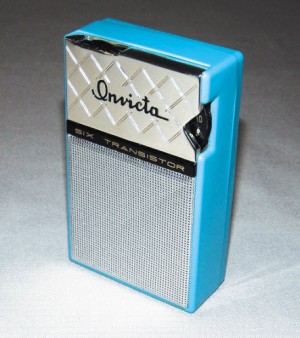There were three things I never left the house without during my high school years; my bucket bag, a can of AquaNet to secure my beehive hairdo and most importantly, my transistor radio.
Watching a recent documentary on the life of the great Dick Clark started me thinking about the importance of music in my life as a teen in rural Indiana. The Doors, The Monkees, Diana Ross and the Supremes, and Smokey Robinson opened up a magical world to an impressionable young girl who had, up until that time, had only been exposed to church hymns and the soundtrack from Oklahoma. Music was a daily influence in my life, made possible by the invention of the transistor radio.
The earliest transistor radios, Texas Instruments’ Regency TR-1 and Ratheyon’s 8-TP-1, sent the world of music mobile in 1954. With a price tag of $49.95 they were a luxury item at first. However, the entry into the marketplace by such American electronics giants as Admiral, Emerson, RCA, GE, Motorola and Philco, and fierce competition from Japanese manufacturers, gradually reduced their price. By the 1960s transistor radios were easily found in the $15 to $20 range, catapulting sales during that decade into the billions.
The huge success of the “TR” speaks to the social attitude and economics of mid-20th century America. The post-World War II Baby Boomers were now in their teens, the general public was experiencing a time of prosperity and disposable income, and everyone under the age of 20 was obsessed with rock ‘n’ roll music.
While some look only for radios from a specific manufacturer or their country of origin, it is more common for collectors to watch for a wide range of transistor radios. These collections not only pay homage to the development of electronics, but they give us an overview of our ever-changing culture. Watch for radios with their original box, leather case, earphones, owner’s manual and warranty card as the presence of these accessories will greatly improve value.
If you are out this summer “junking” at estate sale and flea markets, here are a few radios to watch for. The 1957 TR-63 by Sony, which was the first actual pocket size; the 1958 reverse painted transistor radios that had all of the artwork on the inside of the hard plastic dial cover; and the novelty radios of the 1960s and 1970s featuring cultural icons. Two of my personal favorites are The “Jimmy Carter Peanut” and the “Mork from Ork Eggship.”
Transistor radios were made between 1954 and 1963 will be AM only. They can be identified by the Civil Defense marking (triangles, arrows and dots) on their dials. General Electric made the first AM/FM portable radio in 1961. A rarity at its inception due to the problems of making germanium transistors that would work at high frequencies, it was quickly improved upon by Philco, who developed high frequency RF transistors in 1962.
The last American made transistor radio, the Zenith Trans-Oceanic 700, came off the assembly line in 1970. It was the end of an era in American electronics, but only the beginning of a wonderful category of collectibles. Until next time… Linda
Linda Kennett is a professional liquidation consultant specializing in down-sizing for seniors and the liquidation of estates and may be reached at 317-258-7835 or lkennett@indy.rr.com



